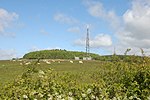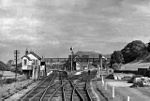Long Mountain transmitting station

The Long Mountain transmitting station is sited on a 400 metres (1,300 ft) ridge about 4 kilometres (2.5 mi) east of Welshpool in Powys, Mid Wales and has been broadcasting UHF terrestrial TV and VHF FM radio services since the late 1970s. The site has a self-supporting 170' (52 metre) high lattice steel mast and was fed with an SHF link from Blaenplwyf via Llangurig. Despite not taking its signal off-air, it was originally classed as a 625-line UHF TV relay of Blaenplwyf. The transmitter originally radiated 1 kW providing TV and radio to an area including Newtown and Oswestry. Being only 400 metres (1,300 ft) from the England/Wales border, coverage extended to several towns in England – Shrewsbury included.Long Mountain became re-classed as main transmitter in its own right (albeit a very low power one) with the advent of digital terrestrial TV from the site on 4 November 2009. In addition to this, it currently transmits FM radio and a single multiplex of DAB Digital radio.
Excerpt from the Wikipedia article Long Mountain transmitting station (License: CC BY-SA 3.0, Authors, Images).Long Mountain transmitting station
Binweston Lane,
Geographical coordinates (GPS) Address Nearby Places Show on map
Geographical coordinates (GPS)
| Latitude | Longitude |
|---|---|
| N 52.6452 ° | E -3.0865 ° |
Address
Beacon Ring
Binweston Lane
SY5 9GL , Forden with Leighton and Trelystan
Wales, United Kingdom
Open on Google Maps







